Germany had the most powerful air force in Europe when the World War II started. It was a bitter truth for the Allies, forced to deal with a strong, well trained, and modern Luftwaffe (the German air force) that appeared seemingly from nowhere. For more than five years after seizing the power, Hitler managed to mask his real intentions by ordering apparently civil aircraft; planes that could be easily turned into military planes, though. Such is the case for the Heinkel He 111; an inoffensive commercial plane when first designed, but actually a bomber in disguise. This was one of the tricks Nazi Germany used to build a powerful and up-to-date army, with modern fighters like the Messerschmitt Bf 109.
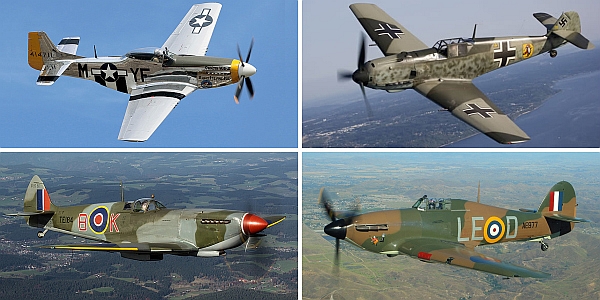
Revolutionary aircraft tested in battle, and experienced pilots, many of them already aces in Spain during the civil war; that is what Allies had to face at the beginning of the Second World War. But the Luftwaffe was made of aircraft that could be shot down; it was strong but not invincible and this fact became very obvious for the first time during the Battle of Britain. It was the struggle when the Hawker Hurricane and the Supermarine Spitfire had their finest hours; soon after that came the P-51 Mustang, the stallion that delivered the final blow to the Luftwaffe.
The enemy
Messerschmitt Bf 109
For a long time, the main fighter of the Luftwaffe, the famous Messerschmitt Bf 109 was designed by the Willi Messerschmitt. A revolutionary aircraft at that time, and definitely one of the first modern fighters, the Bf 109 included features such as a closed canopy, a fully retractable landing gear, and an all-metal monocoque design.
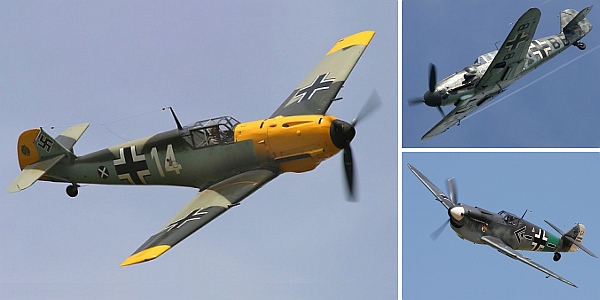
The prototype Bf 109V-1 had the first flight in September 1935. As the 610hp Junkers Jumo 210A wasn’t available at that time, the constructor opted for the British 695 hp Rolls-Royce engine. The prototypes for the series productions (the Bf 109B) were eventually powered by the Junkers 210 engine and had two machine guns and a single 0.20 mm Oerlikon cannon. Two years later, in 1937, three of the Bf 109 prototypes were sent to Spain to be evaluated in combat conditions. Here, they proved much superior to every fighter encountered; actually, the Bf 109 use in the Spanish civil war allowed the Luftwaffe to design and develop the fighter tactics applied with such a great success in the early phases of the World War II.
The Bf 109 saw action even after the war ended. Some Bf 109 produced in Czechoslovakia (the Avia S-199) were acquired by the Israel in 1948 that used them in the Arab-Israeli war.
UNKNOWN FACT
The BF 109 might not have existed if Willy Messerschmitt didn’t manage to sign a contract with a Romanian company in 1933 for a transport plane. This irritated the Reichsluftfahrtministerium (RLM or the German State Ministry of Aviation) forced this way to award a first big contract for a modern high-speed fighter monoplane to The Bayerische Flugzeugwerke – the factory managed by Willy Messerschmitt.
The Allies
1. Supermarine Spitfire
A symbol of the Second World War dogfights, the Supermarine Spitfire was the first fighter truly able to rival the German planes. The fighting qualities of this iconic plane shined during the Battle of Britain when the Spitfires fenced the Bfs 109 for the first time, and with great success.
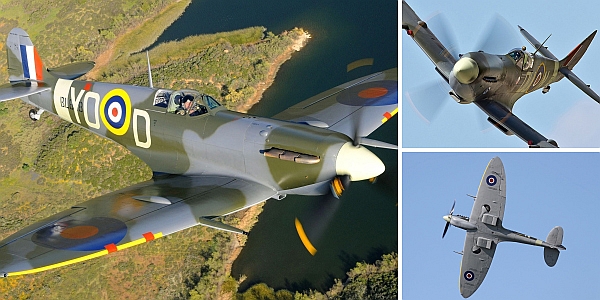
The Spitfire had a modern design for that time with features like the elliptical shape wings and a fully retractable landing gear; it is said many new pilots crash landed as they forgot to put the landing gear down, thinking it was already in the right position, ready for landing.
It was fast, with a high rate of climb but also very well balanced. The pilots praised the amazing balance of the Spitfires that allowed them to “fly themselves”. This particular property saved many pilots’ lives; if a pilot lost consciousness through lack of oxygen, the plane would lose altitude and correct itself.
The Supermarine Spitfire took off for the first time on the 5th March 1936 and entered the Royal Air Force (RAF) two years later. It became the main British fighter plane during the Second World War, but it remained in service quite a long time after it ended, until 1955.
The Spitfire gained respect not only from the British pilots but from the enemy himself. As the Battle of Britain wasn’t progressing as expected, Hermann Göring – commander of the German Air Force – gathered the pilots asking them for explanations. Fact or fiction, it is said that the ace Adolf Galland explained the reason for the slow advance of the operation with a stunning request to his superior “I should like an outfit of Spitfires for my group”.
UNKNOWN FACT
The Supermarine Spitfire was a multipurpose aircraft, and some of its uses weren’t warlike at all; several Spitfires had some modifications to their wings that allowed them to carry barrels of beer instead of bombs; this way, the troops could enjoy some cool beer after the planes landed.
2. Hawker Hurricane
The Hurricane prototype left the ground for the first time in 1935 and entered the production a year later. Created initially as an interceptor, the Hawker Hurricane would be soon outclassed by other fighters from that time, being rather obsolete when the Second World War started. This didn’t impede the RAF to use it with some success during the Battle of Britain when it proved its value for the first time.
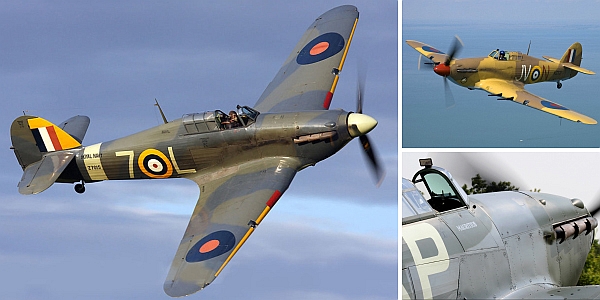
Many pilots praised the unusual strength of this fabric covered fighter, with a fuselage made of braced steel tubes and wooden frames. It had a powerful and reliable engine, and as a whole the Hawker Hurricane was an accurate and excellent flying machine.
Able to take strong punishment from the enemy aircraft, along with a very good steadiness for shooting, Hurricane was a strong and reliable teammate, able to provide a cover for Supermarine Spitfires. In mixed formations, the fast Spitfires were engaging the enemy fighters, while the strong Hurricanes were dealing with the bombers.
But the Hurricanes had also flaws. The main problem that could never be solved entirely was the carbon monoxide leaking into the cockpit. Many attempts were made to fix this issue like outfitting the planes with longer exhaust stubs but in vain. Eventually, the only reliable solution was instructing pilots to keep their oxygen masks on permanently during the entire flight, until the engine was shut down.
UNKNOWN FACT
Nearly 3,000 Hurricanes (almost a quarter of the total amount of aircraft manufactured in the United Kingdom) were purchased by the Soviet Union. Actually, the Hawker Hurricane was the most numerous British plane used by the Soviet air force during the World War II.
3. P-51 Mustang
As a veteran of the World War II and later the Korean War, the North American P-51 Mustang was the toughest shot for the Luftwaffe. During the Second World War, Mustangs faced and defeated every German fighter, from the early piston-engined aircraft to the modern, fast and powerful twin-jet Messerschmitt Me 262.
North American Aviation (NAA) designed and built the Mustang in an effort to accomplish a requirement that was issued to the company by the British Purchasing Commission. On the 9th September, only 120 days after the contract was signed, the NAA revealed the prototype NA-73X that made the maiden flight on 26th October.
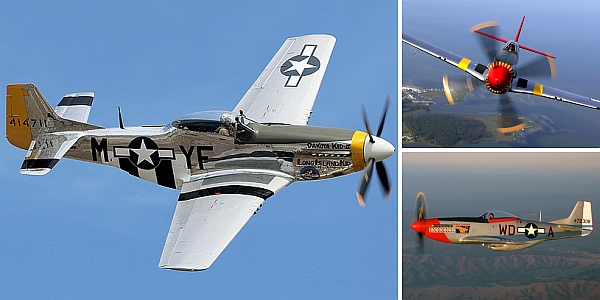
The North American P-51 Mustang was a very maneuverable aircraft, with a good rate of climb. It was fast, with a remarkably good high speed in level at any altitude, however, the extraordinary long range made the Mustang a unique plane at its time. Actually, it was the best bomber escort primarily due to that unusual long range. A pilot may prefer to fight a dogfight with a Spitfire, but not in Berlin; a Spitfire could never get him home to Britain from Germany, remembers a British pilot.
Designed initially as a medium-altitude fighter plane, the North American P-51 Mustang was a powerful fighting machine that did a wonderful job also in hedge-hopping strafing runs, and many other roles. It became famous for blasting ships, enemy trains, convoys, military bases, trains and rails in the Western Europe. In Italy, the Mustangs hit permanently the Axis defense and helped clearing the way for the Allies during and after the invasion of Sicily. The P-51 Mustang had such a great impact over the Luftwaffe, that Hermann Göring admitted “When I saw Mustangs over Berlin, I knew the jig was up.”
UNKNOWN FACT
The P-51 “served” also in the Luftwaffe. Several Mustangs damaged after landing ended in the German air force by accident. The Germans repaired the captured aircraft and used them for testing purposes.
Of course, more than three aircraft were involved in winning the war over the mighty Luftwaffe. But these three Allied planes along with the aircraft built by the Germans were more than efficient weapons, they were primarily some engineering marvels that pushed forward the development of the aviation.
Guest post by Marius Bujor of behalf of Scale Model Aircraft – The Scale Modeller’s Aviation Database
References
Fighters 1939-45: Attack and Training Aircraft, by Kenneth Munson
German Aircraft of the Second World War
Warplanes of the Luftwaffe – Combat Aircraft of Hitler’s Luftwaffe 1939-1945, J. R. Smith
Supermarine Spitfires and Hawker Hurricanes: World War II Aircraft by David Alan Johnson, Aviation History, November 1994
The Complete Encyclopedia of Flight 1939-1945 by John Batchelor, Malcolm V. Lowe
The Encyclopedia of Military Aircraft: Over 650 Entries from 1914 to the Present Day by Robert Jackson
The Illustrated Encyclopedia of Military Aircraft 1914 to the Present by Enzo Angelucci
